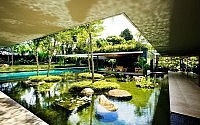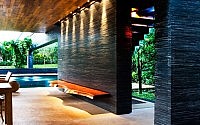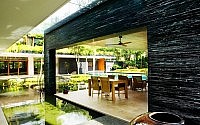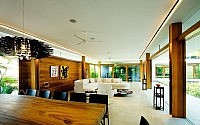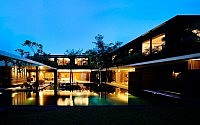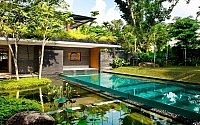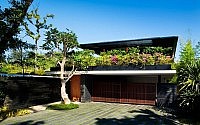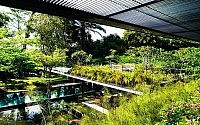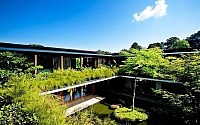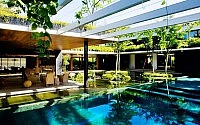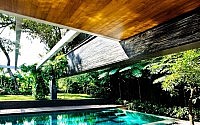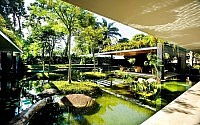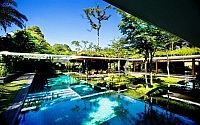Cluny House by Guz Architects
Tropical courtyard house with an identical parti to the Sun House designed by Guz Architects situated in Singapore.















Description by Guz Architects
On a relatively small site at the end of a cul-de-sac, Wilkinson designed a tropical courtyard house with an identical parti to the Sun House: two pavilions on an L-shaped plan are placed at the perimeter, looking over a water garden comprising a large fishpond with an archipelago of tree-filled islands, which appears to merge with a lap pool encased in a sheer glass rim. These two houses are described by Wilkinson as his ‘most watery’, and the Cluny House does reinforce the oft-repeated observation that small tropical houses come alive when water is used as the focal point of a central courtyard. But to refer to this house as small seems rather incongruous, as the scale and transparency of the landscape, and the reflections of the sky and trees in the pond, conspire to allude to the infinite, with the architectural massing all but hidden. Wilkinson was using the water garden to draw the eye away from the structure and the elements, thus creating an over-riding illusion.
At the request of the client, the main staircase was enclosed within the house, a decision that prevented the usual two-level promenade architecturale of Wilkinson’s open circulation routes, which pass through an exposed staircase zone. As the house thus comprises two discrete floors, it possesses a distinctively dissimilar appearance on elevation to his contemporaneous houses. Wilkinson was able to turn this to his advantage, however, as by cantilevering second floor roof gardens along the length of the uniform elevation, he created a barrier of greenery to screen the upper level, so that the mass of the house appears recessed, hidden by the plantings. Further visual trickery was employed in the landscaping to hide the proportions of the architecture: Wilkinson was concerned that the proportions of the open verandah, projecting into the water garden, would appear short and stubby, so he spanned a vine draped trellis over the pool to continue the form and length of the fin-wall in the verandah.
The Cluny House was orientated towards its views, but every view is internal, confined within the boundaries of the site. Wilkinson designed a completely self-referential world, which provides its own delights and creates its own micro-climate. The most sublime vista is to be had from the long L-shaped walkway beneath the lip of the cantilevered roof gardens, where the low wide soffits ripple and sparkle in the sunlight reflected from the surface of the ponds. The panorama of tropical fecundity is languid and luscious, framed and contained by Wilkinson’s careful delineation of line and edge.
- by Matt Watts